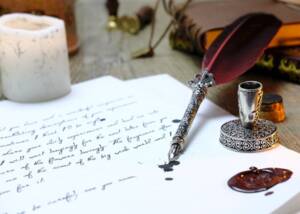Cotillon articles: Effective paper goods for the ballroom
News News blog
Cotillon articles, usually abbreviated to cotillons, were strikingly decorative, factory-made paper goods that played an important role at balls between 1860 and 1914. At the cotillon, the highlight of every ball, they were distributed to the dancers to be given as gifts between the couples.

The cotillon - a special dance
The cotillon was a varied succession of contra dances, polkas and waltzes with playful interludes in which the couples formed alternating groupings. A party organizer announced the numerous tours and enriched them with donations of flowers to the ladies, paper medals to the gentlemen, distribution of firecrackers and other surprises that required all kinds of props, mostly made from cheap paper materials.
The variety of cotillon items
Among the cotillions used were fans, ball gifts, dance cards, firecrackers, cotillon medals, paper flower bouquets and dance controllers. In a broader sense, they also included other festive items such as paper hats, garlands, lanterns, paper sashes and bows. Many resembled carnival articles and were offered by the same manufacturers.
Cotillon medals as a highlight
The cotillon medals were a particular highlight. As fantasy or joke medals, they were used to bring dancing couples together in a playful way during the cotillon. Available in various price categories and designs, the simple versions were made of embossed cardboard, while the high-quality examples were decorated with chenille, glass beads, crepe and other materials. They often bore inscriptions such as "For lively dancing".
The magnificent medals were very popular at the balls. Some dancers kept them afterwards as a memento or even hung them on the Christmas tree. Until 1914, cotillon medals were produced in great variety by numerous companies. In Berlin alone, there were eight manufacturers around 1870.
The end of an era
With the First World War and the social changes in Germany after 1918, the era of glittering ball nights came to an end, and with it the era of cotillon articles. During the Weimar Republic and the Third Reich, there were only a few suppliers left and demand was limited to dance schools.
Today, cotillon items are a rarity and valuable witnesses to a bygone era. They are reminiscent of the splendid balls of the German Empire, where ladies in glittering gowns and gentlemen in uniform waltzed and small paper objects served as status symbols. Collectors and lovers of historical paper goods appreciate the artistic and imaginative artifacts from the heyday of cotillon culture.










